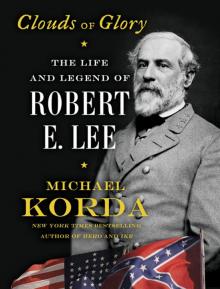- Home
- Michael Korda
Clouds of Glory Page 22
Clouds of Glory Read online
Page 22
If nothing else, Molino del Rey underscored the value of Lee’s gift for painstaking reconnaissance and his careful siting of artillery before an attack. These gifts were now put to use to find the best way of attacking Mexico City from the south. Accompanied by two other engineering officers, he managed to get “within a mile and a quarter of the city” and observe what the Mexicans were doing to improve defenses. Lee was impressed and became uncharacteristically cautious about the possibility of assaulting Chapultepec, but he was convinced that the city could be taken by well-coordinated attacks from the south. He spent September 9, 10, and 11 in continuous reconnaissance, with almost no rest, looking for the best places to site artillery; but at a “council of war” on the night of September 11 Scott finally decided to attack Chapultepec instead, convinced that a well-conducted artillery bombardment could drive the Mexican defenders out of the fortress, and that once Chapultepec, with its summit overlooking the western wall of the city, was captured, Mexico City would be open to a sustained attack. With American artillery placed on it, the hill would dominate the two western approaches to the city, which was only a mile away. Although all the officers present except Beauregard (and, eventually, Twiggs) supported Lee in arguing against the attack, it is a measure of the respect they had for Scott that they accepted his decision instantly. Here too, Lee learned something: a commanding general should always listen to the opinions of his senior commanders, but once he made up his mind, he had to be obeyed. Like General Scott, whose example he relied on, Lee knew how to cultivate the respect and even the awe of those who disagreed with him. But like Lee’s preference for good manners over direct orders, at times this came at a price, as it did for Scott at Molino del Rey, and would for Lee himself at Gettysburg.
Whatever his reservations Lee flung himself into the preparations for the attack on Chapultepec during the next forty-eight hours, exhausting himself in the process. Assisted by Lieutenant George B. McClellan, he placed four batteries of heavy artillery, working so quickly that the first two batteries could open fire in the morning of September 12, less than twenty-four hours after Lee had received his orders. Enormous labor and danger were involved in bringing 8-inch howitzers and 16- and 24-pounder guns across soft, marshy ground and siting them onto platforms that had been dug by pick and shovel to receive them, all of this in full view of the enemy and under constant enemy fire. Once the guns were in place Lee went forward to examine the approaches to Chapultepec more closely. He was so absorbed in his task that General Scott had to send an officer to bring him back to his headquarters in Tacubaya. There, Lee found Scott in a rage. He had not received any reports about the effect the bombardment was having on the Mexicans holding Chapultepec. Scott was determined to attack that evening, and had ordered one division to the west through the dense cypress grove at the foot of Chapultepec, and another to attack from the south, directly up the steep road cut into the cliff face. The volunteers had been formed into two “storming parties,” equipped with “scaling” ladders, to lead the assault. It fell to Lee, as the senior engineer officer present, and the one who had ventured closest to Chapultepec, to talk General Scott out of a night attack. Lee was then ordered to brief the commanders who would carry out the attack—one senses the possibility that Scott was under too much nervous strain to do so himself—and during the night the troops moved into their positions west and south of Chapultepec, while others made “an ostentatious demonstration” before the southern gates, intended to fix Santa Anna’s attention in the wrong direction.
Lee spent the night inspecting the batteries and making sure that damage caused by Mexican return fire was quickly repaired. By now he had gone forty-eight hours without sleep, but his orders were to guide General Pillow’s division in its attack on the western face of Chapultepec. He set out with the leading parties as soon as the bombardment ceased at eight o’clock in the morning on September 13, exposed to artillery fire, musket fire, and—a novelty for the day—buried land mines, most of which fortunately did not go off. He watched while the scaling ladders were brought up, and the storming parties were pushed back with heavy casualties. He regrouped the troops and the second attempt was successful. Lee himself climbed up the steep slope to the terraces at the top, accompanied by Lieutenant James Longstreet, who would be his corps commander on the right on the fatal third day of the battle of Gettysburg; and by Lieutenant George E. Pickett, whose division would make the attack on Cemetery Ridge, the last act in that great, heroic tragedy. At some point in the assault, Lee was “lightly wounded,” but he managed to help the wounded General Pillow to safety, then climbed to the summit in time to see the American flag raised. The “fortress” itself turned out not to be as formidable as had been feared. It had been built as a palace, and did not offer much in the way of protection to the Mexican soldiers who took refuge there. The huge building was taken room by room, many of the American soldiers running “wild, looting and hunting down the now defenseless Mexicans in retaliation for the atrocities of Molino del Rey,” but knowing what we do about Lee we may be sure that he was among those firmly restoring order and discipline to the troops. Since he never mentioned it, he was probably not a witness to the actions of the fifty to 100 (accounts differ) cadets of the Mexican military academy who became Mexico’s famous Niños Héroes.* Six of them fought to their death, and the last boy, Juan Escutia, wrapped himself in the Mexican flag that had flown over Chapultepec and flung himself from the parapet to his death rather than let it fall into the hands of the hated yanquis. As Lee watched the Stars and Stripes raised over Chapultepec to replace the Mexican flag, the fifty captured soldiers of the St. Patrick Battalion of deserters who had been condemned to death were hanged, after waiting for two hours in the sun, a noose around each neck, as the battle was fought. Thirty of them were hanged in full view of the battle, each of them standing in the back of a mule-drawn cart, hands tied behind them, the noose already fastened to the immensely long crosspiece of a huge mass gallows built for the purpose on a low hilltop facing the fortress. At the moment when the American flag was raised above a cloud of black smoke around Chapultepec, teamsters whipped the mules, and the deserters dropped to their death amid the sound of cheering from their former comrades in arms.
Despite numerous conventional patriotic paintings of the assault on Chapultepec, there is a certain Goyaesque horror to the entire episode, between the boy soldiers and the hanging of the deserters, not to speak of the bayoneting of Mexican soldiers who were trying to surrender.
It certainly had an effect on the defenders of Mexico City, as Lee, who was by then exhausted and had not even paused to get his wound dressed, instantly realized. With the American victory at Chapultepec, organized Mexican resistance collapsed. He made his way back to Scott, reported the overwhelming success of the attack, carried out yet another reconnaissance of the ground toward the San Cosme gate at the northwestern corner of the city, and returned once more to Scott’s side, where, for the first and only time in his life, he fainted. He had been on his feet or in the saddle for three days and nights without rest.
When he came to before dawn, he learned that American troops had already entered the city and seized the citadel, and that Santa Anna had fled. Lee himself entered Mexico City at first light and was watching in the grand plaza as General Scott rode in about eight in the morning in full dress uniform to see the American flag raised over the National Palace. After this Scott reviewed the troops as they presented arms, then dismounted, doffed his plumed hat, and entered the palace.
For two days the American occupiers were forced to fight street battles with armed criminals whom Santa Anna had released from prison. These shots would be the last fired in action that Lee would hear until 1861. When the Duke of Wellington heard the news of the capture of Mexico City he proclaimed Scott “the greatest living general.”
It would take almost a year before the peace was ratified by the American and the Mexican congresses, and celebration of the fact that the United States
had been almost doubled in size was muted by endless squabbles between Scott and his generals, and between Scott and President Polk. In the end Polk relieved Scott of his command. Lee never lost confidence in Scott, and complained that the general was “kicked off . . . and turned out as an old horse to die,” strong words from Lee. As for Lee’s own experiences in Mexico, he remarked that “we bullied [Mexico] . . . for that I ashamed, for she was the weaker party,” a point of view shared by many Americans. Indeed, seldom has so great a conquest brought such dire consequences for the victor.
For his part in the assault of Chapultepec, Lee was promoted to brevet colonel, the highest rank he would reach until 1861. More important, he had gained a unique opportunity to learn the art of generalship under the command of an expert, who valued and trusted him at a level far above his rank. Lee had shown himself a master of reconnaissance, and he had learned the value of audacity in warfare and the importance of the bold flank attack, as well as the possibilities of advancing swiftly beyond the conventional lines of communication and “living off the country.” Again and again in his “second career” at war, he relied on the lessons he had learned from Scott, and from his own experiences in Mexico.
He also learned much about his own fellow officers that would stand in him in good stead during the Civil War. No fewer than seventy-eight of them would become generals in the Union Army, including Ulysses S. Grant, Winfield Scott Hancock, Joseph Hooker, George Meade, and George McClellan. Fifty-seven of them would become Confederate generals, including Lewis Armistead, P. G. T. Beauregard, Thomas J. (“Stonewall”) Jackson, Joseph E. Johnston, James Longstreet, and George Pickett. Hardly any senior officer on either side of the Civil War was a stranger to Lee.
He returned home at last on June 29, 1848, having been away for twenty-two months. With him were his mare Grace Darling and a little white pony he had bought for his youngest boy. He had earned a reputation throughout the army, in the words of General Scott, as “the very best soldier that I ever saw in the field.”
It would be thirteen years before Lee could put his reputation to the test again on the battlefield.
CHAPTER 5
A Long Peace—1848–1860
“I cannot advise him to enter the army. It is a hard life, and he can never rise to any military eminence by serving in [it].”
—Robert E. Lee to a friend
about his son, May 1856
It is only in fiction that soldiers miss war. Professional soldiers appreciate the fact that the risks of war are balanced out for them by the opportunity for more rapid promotion, but nobody who has made a career of the military relishes being shot at, blown up, or disabled. Lee had the kind of cold courage that every soldier envies, but much as he chafed, over the next thirteen years of peacetime, at his lack of promotion and at the poor pay, he never had any desire to repeat his experience under fire in Mexico City. Far from finding life at home unexciting, Lee was essentially the most domesticated of men, one who hated being separated from his wife, his children, his beloved Virginia, and the great house at Arlington that had become his home. When duty called, he obeyed, but his letters home make it clear that every day away from his family pained him.
It would be hard to find a man less suited to the frequent separations of a military career than Lee, unless it was another West Pointer and Mexican War veteran, Captain Ulysses S. Grant, who reacted to the sheer monotony of life on distant infantry posts far away from his beloved wife Julia by taking to drink, then resigning from the army. Lee, by comparison, had not only the advantage of being a well-connected brevet colonel, but also that of being an engineer, so he was never short of new challenges. The army was still maintaining and enlarging the system of fortresses intended to protect the United States from an unlikely repetition of the War of 1812.
Lee’s arrival home at Arlington had been eagerly awaited by his family, but like many another veteran he arrived unexpectedly, having missed the carriage that was sent for him. The family dog Spec, “a black and tan terrier,” was the first to recognize him; then Lee plunged into the hallway full of children, and picked up and kissed the wrong one, a friend of his son Robert’s. Oddly enough the first memory Robert E. Lee Jr., then five years old, had of his father was this slightly embarrassing event. Years later, he wrote, “After a moment’s greeting to those surrounding him, my father pushed through the crowd, exclaiming: ‘Where is my little boy?’ He then took up in his arms and kissed—not me, his own child in his best frock with clean face and well-arranged curls—but my little playmate Armistead! I remember nothing more of any circumstances connected with that time, save that I was shocked and humiliated.” No doubt Robert soon got over it, for a few days later Lee took him to Baltimore on a visit to Mrs. Marshall (Lee’s sister), then “down to the wharves” to watch the pony he had bought for the boy in Mexico being unloaded: it was “pure white, five years old and about fourteen hands high,” and had been named Santa Anna. Santa Anna and Robert quickly became inseparable companions. The faithful Jim Connally soon arrived with Lee’s mare Grace Darling—Lee had taken a longer, slower journey home, up the Mississippi from New Orleans to Wheeling, in order to spare the horse “as much annoyance and fatigue as possible, she already having undergone so much suffering in my service.” Lee now began every day that he was home by going to visit Grace Darling in her stall, “always petting her and talking to her in a loving way.”
Robert soon came to appreciate that his father was different from other men, and not just in his love of animals. “From that early time,” he wrote, “I began to be impressed with my father’s character. . . . Every member of the household respected, revered and loved him as a matter of course, but it began to dawn on me that every one else with whom I was thrown held him in high regard. At forty-five years in age he was active, strong, and as handsome as he had ever been. . . . He was always bright and gay with us little folk, romping, playing, and joking with us. Although he was so joyous and familiar with us . . . I always knew it was impossible to disobey my father. I felt it in me, I never thought why, but was perfectly sure that when he gave an order it had to be obeyed. . . . When he and mother went out in the evening . . . we were often allowed to sit up and see them off; my father, as I remember, always in full uniform, always ready and waiting for my mother, who was general late. He would chide her gently, in a playful way and with a bright smile . . . and I would go to sleep with this beautiful picture in my mind, the golden epaulets and all.”
Of course it is by no means uncommon for children to idolize their father, but when Robert wrote this he was a middle-aged man and a former Confederate captain, whose father, ironically, had failed to recognize him on a second occasion, this time during the Battle of Antietam (or Sharpsburg) in 1862. Lee, then commanding general of the Army of Northern Virginia, had ridden up to a battery that had been “severely handled, losing many men and horses,” and ordered its captain to take the uninjured men and remaining guns back to the front immediately, without realizing that one of the battle-weary artillery privates standing there was his own son Robert.
The picture of family life summoned up by Robert is vouched for by all the other members of the Lee family, as well as by innumerable people who knew the Lees. Lee, punctual to a fault, is always standing there restlessly; Mary, always late and, despite the help of devoted maids, is slightly disheveled and missing some article that will cause a further delay while somebody goes back to find it. Their lives revolved around their children to a degree that seems very modern—for in the late eighteenth century and through most of the nineteenth children, however loved they might be, were not the central focus of family life that they became in America in the twentieth century. On the frontier and among the poor, the rate of death among infants and small children made mothers hesitate to become too attached to them when they were small, and among the wealthy children were kept out of sight in the nursery, in the care of a nanny. (Lee’s son Robert mentions his “mammy” Eliza, a Lee family slave, as a
major figure in his childhood.) The Lees, to the contrary, seemed to have lived constantly surrounded by their seven children, totally absorbed in their upbringing, their games, and their education.
When Lee returned home after nearly two years away at war his oldest boy, George, known in the family as “Boo,” was sixteen; his daughter Mary was thirteen; his son William, “Rooney,” was eleven; Anne, “Annie,” was nine; Eleanor Agnes was seven; Robert, “Rob,” five; and Mildred, usually referred to by her parents as “Milly” or “Precious Life,” was two—a large family even by early Victorian standards. Lee, whose need to direct and instruct people was in any case highly developed, took fatherhood more seriously than anything else in his busy life, and his letters to his wife, Mary, when he was away from home are full of detailed good advice about bringing up the children, much of which she ignored. The letters he sent to the children themselves as soon as they could read were also filled with good advice.
Photographic portraits taken of Lee during this period of his life show him looking remarkably young for a man of forty, and as handsome as ever—the white-haired patriarch was over a decade away.
To modern readers Lee’s letters to his family may seem exaggeratedly pious—he is constantly thanking God or leaving matters large and small in God’s hands—but it is important to recognize the depth, sincerity, and importance of Lee’s religious belief. It was not an affectation, or a question of style, or an attempt to enforce piety on his children or others; it was a reality at the very core of his being. When he writes to Mary, “I pray God to watch over and direct our efforts in guarding our dear little son,” or to one of his children, “Be true, kind and generous, and pray earnestly to God to enable you to keep His Commandments ‘and walk in the same all the days of your life,’” or to his soldiers, “I earnestly pray that a merciful God will extend to you His blessing and protection,” these are not mere phrases. They mean exactly what Lee wrote. Although the form of his religious observance changed as he grew older, it remained a constant throughout his life.*

 Passing
Passing Another Life
Another Life Clouds of Glory
Clouds of Glory Hero: The Life and Legend of Lawrence of Arabia
Hero: The Life and Legend of Lawrence of Arabia Cat People
Cat People Hero
Hero With Wings Like Eagles: A History of the Battle of Britain
With Wings Like Eagles: A History of the Battle of Britain Ulysses S. Grant
Ulysses S. Grant